Francisco de Jasso y Azpilicueta walked through the streets of Goa with bell in hand to ensure that everyone knew that a messenger of the Lord was making the rounds, and they better get their religious act straight… or else. The else came later, after his death, when on his prompting, the Inquisition was sent to town. He became popularly known as Saint Francis Xavier, patron saint of missionaries and ‘the god of Goa’.
The body of St. Francis Xavier currently resides in the Basilica of Bom Jesus in old Goa, as shown near the top of the following image.
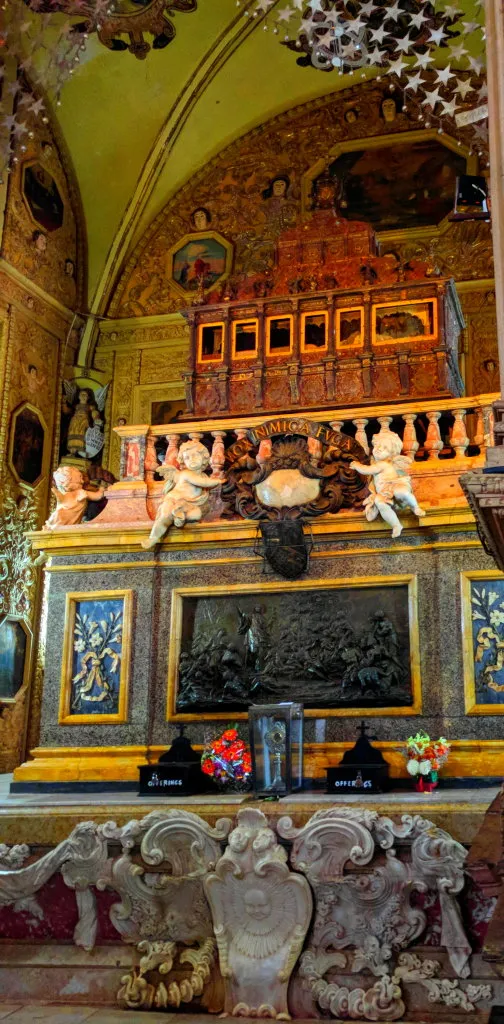
Revered by followers, he was one of the first Jesuits, who conducted extensive missionary work throughout Asia. To say that he was committed to the cause would be a massive understatement. Born to a wealthy family in the kingdom of Navarre, modern day Spain, he attended university in Paris, where he befriended the Spanish theologian and mystic Ignatius of Loyola. Also canonized as a saint, Ignatius of Loyola had some metaphysical ideas and knew certain religious practices(e.g., fasting, meditation, self-punishment, and sexual abstinence) that made an impression on young Francis. So much so, that Francis Xavier was inspired to spread the gospel of Christ and gain more souls from distant lands in the East.
On the morning of December 31, Bianca and I had an invigorating breakfast then went out to look for a taxi to take us to Old Goa. We had read that the fare was between 600 and 700 rupees. The first driver to approach us offered to take us for 2000. I countered-offered with 1500, but he simply shook his head and walked away. We were in no particular hurry, so we kept going. Another driver approached us soon enough and said he would take us for 2000 but agreed to do it for 1500.
“What is your name?” Bianca asked the driver.
“Philip, madam!”
He explained how it was the holidays, and it was very busy because people were trying to get to the beach. This is why he wanted to charge us 2000 rupees.
“What is going on at the beach?” Bianca asked him, tactically shifting the conversation away from the heavy traffic.
“The fireworks. Many people come from everywhere to see tonight. Very busy.”
“Are you going?” I said.
“No, no. Maybe I go early. Later… too many people.”
I looked out the window at the eclectic neighborhoods with the old houses built in an assortment of Indian and colonial designs, billboards and ads dotted the urban landscape haphazardly, bright colorful and mysterious temples materialized in the ebb and flow of traffic, voices and laughter in a mixture of local and foreign tongues, a massala dish of culture steaming beneath the fanning flames of the Goan sun.
In one of the Indian temples, the ladies looked wonderful in their colorful saris and the men looked sharp and spiffy in long-sleeved shirts and dark pants. It looked like some kind of event was taking place.
“New temple festival,” said Philip, our driver. “Early this morning. It’s over now.”
“We missed it!” said Bianca snapping her fingers.
“Different temples for different people. Shiva, Ganesh, Hanuman… different, different.” He mused about how there were different religions in Goa with different temples and modes of worship. Some groups went to the temple several times throughout the week.
“Christians go to church only Sunday,” he said chuckling. “Only Sunday.” He laughed and shook his head in amazement as if he couldn’t believe that they could get away with that little amount of church time.
We drove into Old Goa and then Philip told us where to meet him after we were done sightseeing. He pointed at the main attractions in this area. First, we made our way to the Basilica of Bom Jesus, a large cathedral built in the early part of the 17th century, and which now contained most of the body of St. Francis Xavier.
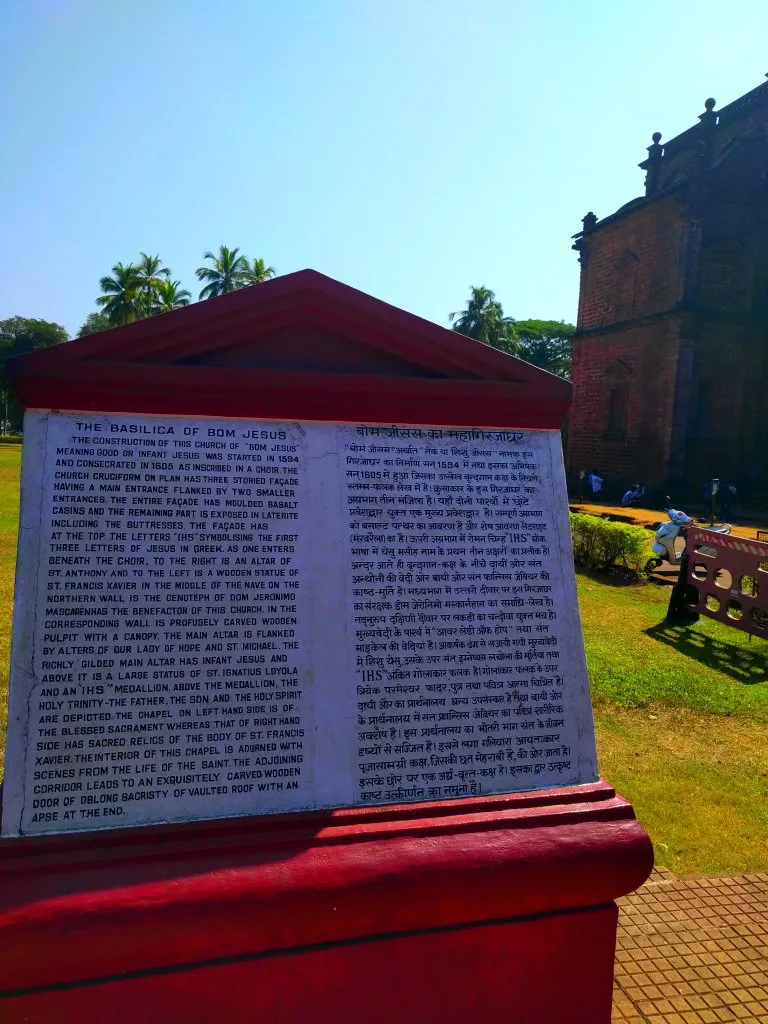
For a layman like myself, it is difficult not to look at some historical events and wonder what the heck they were thinking back then. In other words, I’m judging events through the lens of my own enculturation that includes centuries of development in mass media, education, economics, politics, science, technology, and so forth. It is an extremely biased perspective.
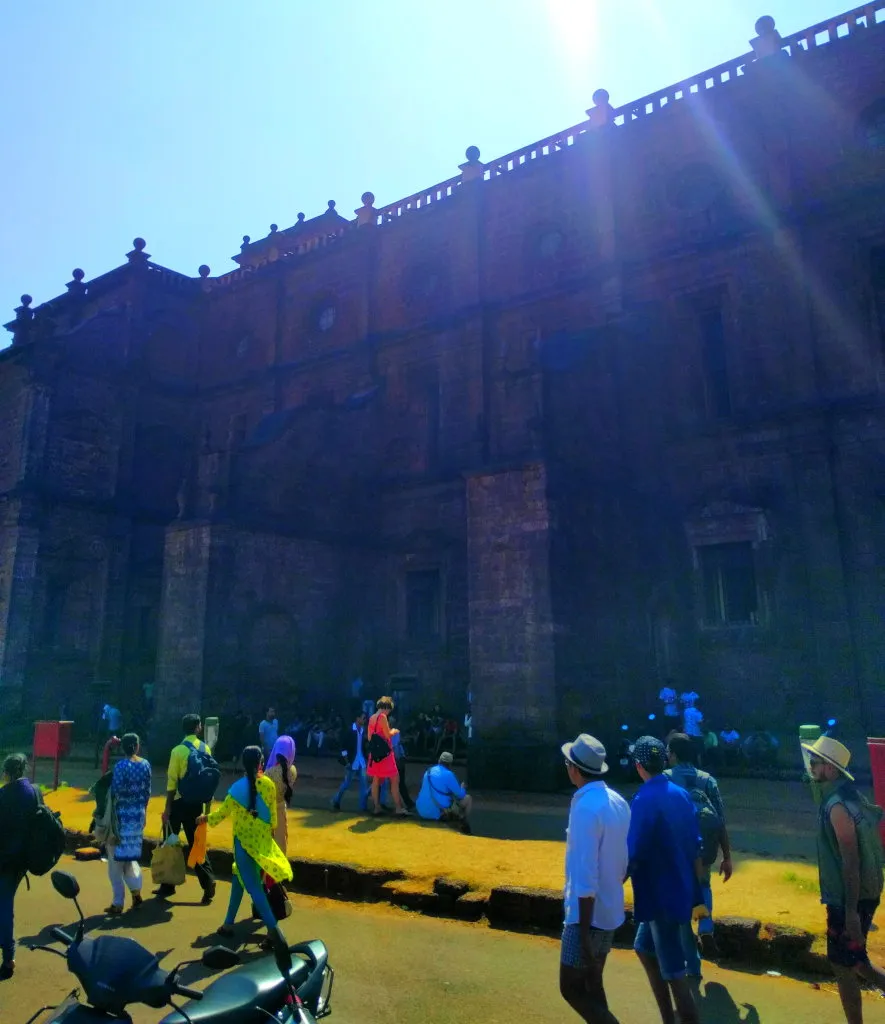
As defined in Wikipedia (2022),
Anthropology is the scientific study of humanity, concerned with human behavior, human biology, cultures, societies, and linguistics, in both the present and past, including past human species.
The key word here is scientific. Early anthropological work was rife with the cultural pseudo-scientific biases of the era, particularly the idea that human progress was a rigid linear development from a primitive to advanced civilized state. So investigators used the norms and behaviors of their own culture to understand the norms and behaviors of other cultures, leading to erroneous conclusions. This all changed when anthropologists like Franz Boas and others began working with a framework of cultural relativism that tried to understand cultures in their own terms, not those of the ‘dominant’ culture.


As I wandered the streets of Goa, I just couldn’t fathom the idea of a bunch of dudes with an entirely different bio-cultural identity showing up at my doorstep one day and announcing that I was now one of them. At least partially. Say goodbye to my traditions, norms, and beliefs. Even dietary changes were in order. Those statues and temples? They gotta come down too. Put up these other ones instead. The freedom barbarian in me just bristles at the idea. Yet, I cannot escape that cultural relativism that urges me to understand past cultures, including Christianity, within the context in which events took place so long ago.
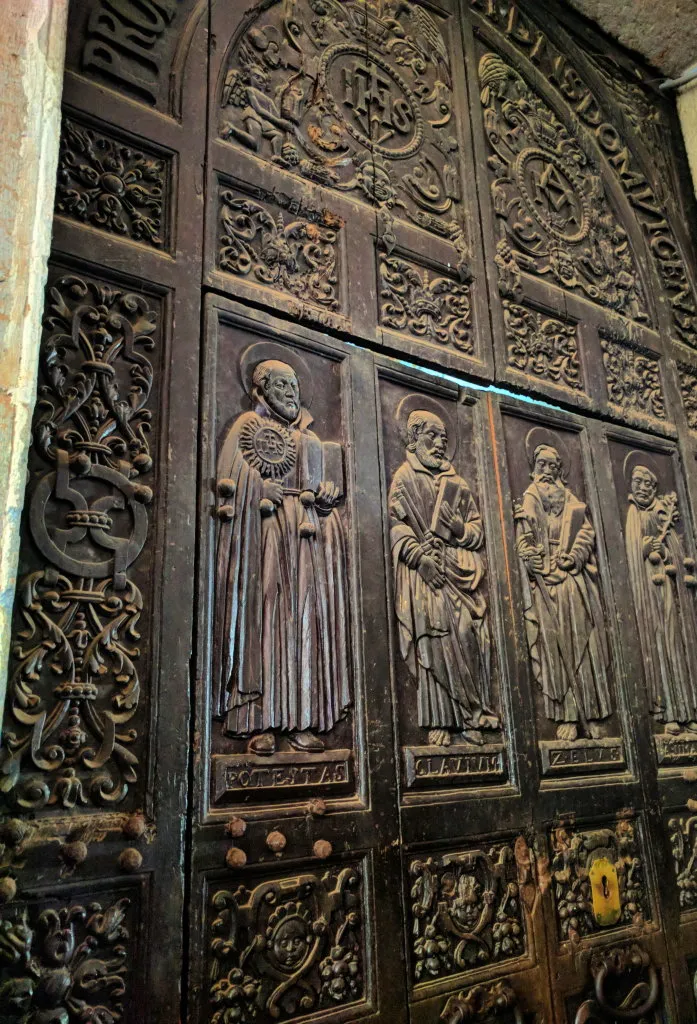
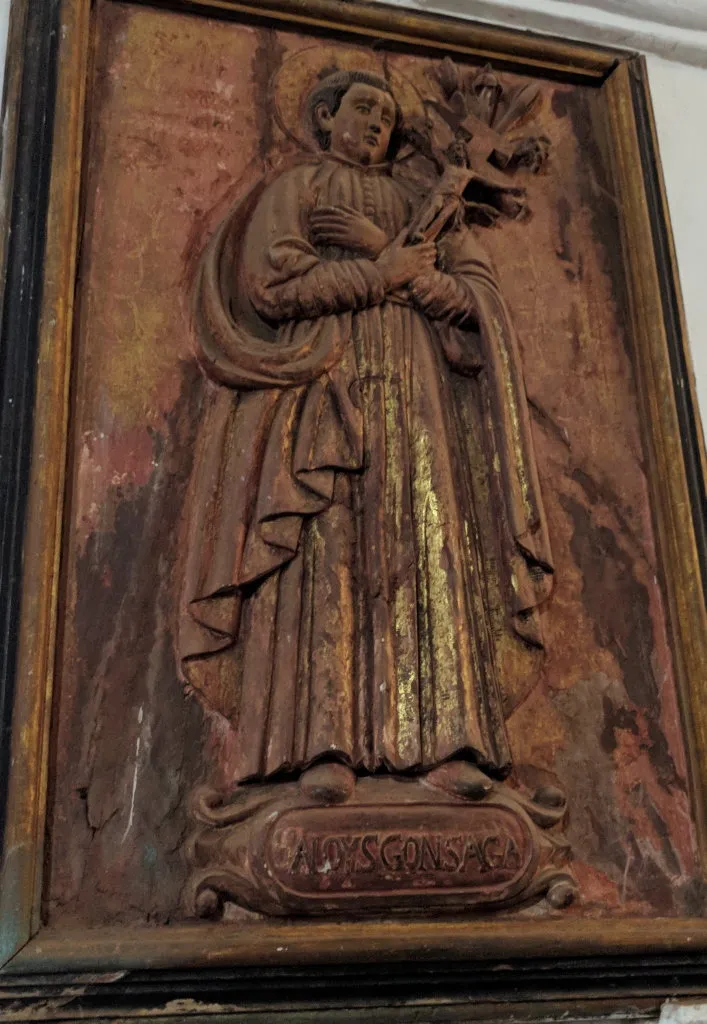
On April 7 of 1541, Francis Xavier traveled from Lisbon to Goa and arrived 13 months later. From there, he embarked on a missionary crusade to bring the locals under the umbrella of Christendom. He was relentless and is believed to have baptized some 30,000 people, in addition to his work with the poor.
Being a westerner, I have seen my fair number of churches, including a share of them in Spain and Portugal. So, I found it kind of humorous to have traveled halfway across the world to visit yet more Christian churches in one of the most exotic non-Christian lands in the world. Nevertheless, my imagination went into overdrive thinking about those wild Europeans that came to live (and often die) in India. What a mysterious epoch of colonization that must’ve been. There’s a reason Goa used to be called the Venice of the East.
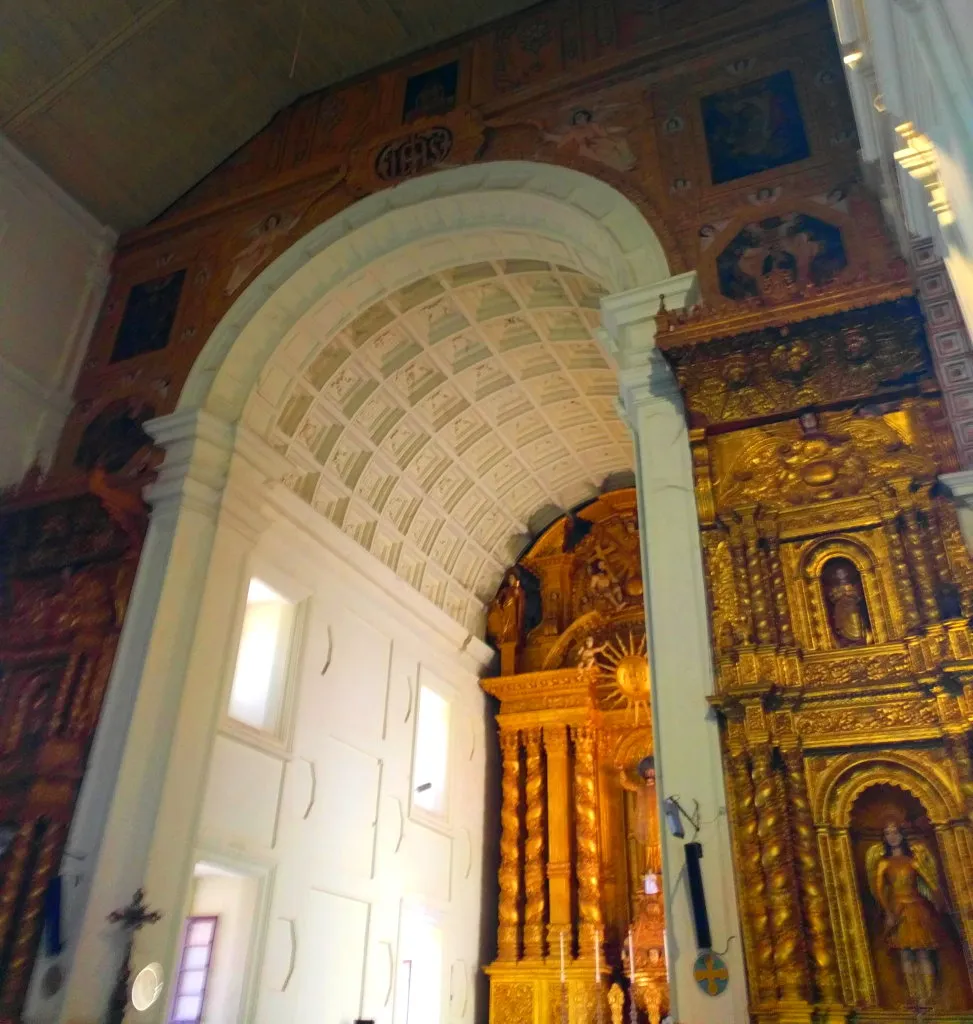
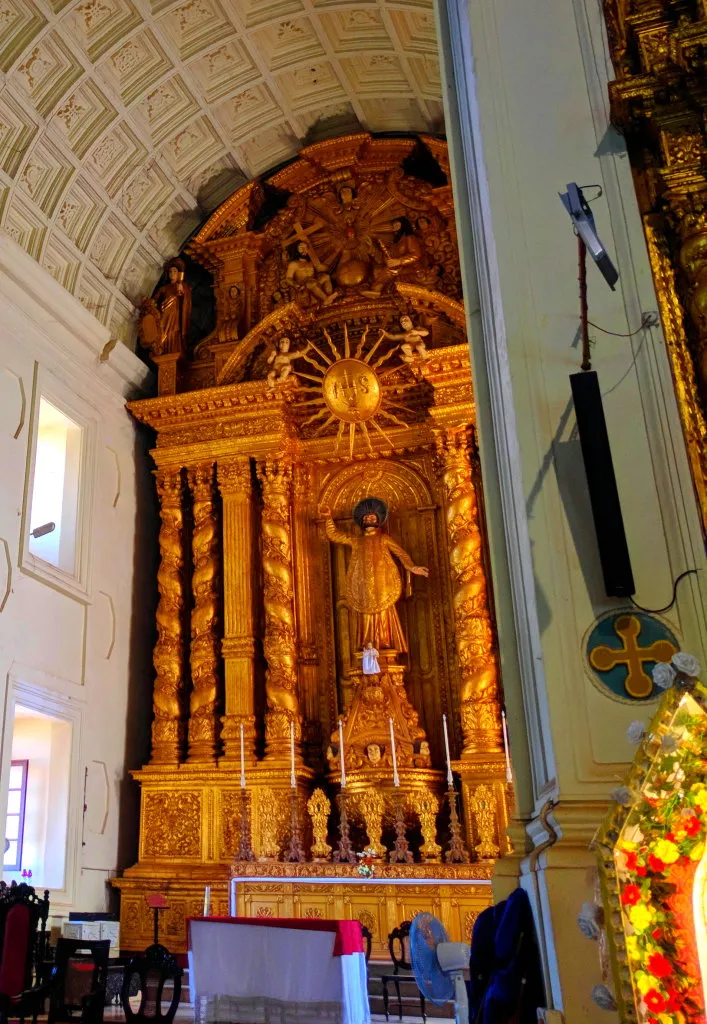
Indian temples tend to be colorful and extravagant. Statues (sometimes in erotic poses) adorn the swirling and sensuous facades. So what did the local population make of Christian churches with their tall architectural peaks, broad and ornate archways, glistening golden walls, and the austere paternal figures posing with such a stern demeanor?
While he continued his mission with great zeal, eventually the religious conflicts with those who opposed Christianity grew to the extent that in no uncertain terms St. Francis Xavier called in the cavalry.
there is the need of the Holy Inquisition and of many preachers. Your Majesty should provide such necessary things for your loyal and faithful subjects in India.
- Letter addressed to the King of Portugal on May 16, 1545. Joseph Wicki, Documenta Indica, Vol. IV, Rome, 1956. quoted from Goel, S. R. (1985). St. Francis Xavier: The man and his mission. Retrieved from Wikiquote on August 19, 2022.
Francis Xavier continued his travels through the east and died while waiting for documents to enter China. His body was then brought to Goa where it was venerated and celebrated every December 3 by Christian worshipers. Up to relatively recently, the body could be viewed openly but then was placed in a glass casket after a follower bit one of its toes and one of his arms ended up in Rome.

We visited Sé Catedral de Santa Catarina across from the Basilica. The exterior has the typical Iberian architecture of the time. Wikipedia describes it thus:
The architecture style of the Se Cathedral is Portuguese-Manueline. The exterior is Tuscan, whereas the interior is Corinthian. The church is 250 feet (76 m) in length and 181 feet (55 m) in breadth. The frontispiece stands 115 feet (35 m) high.
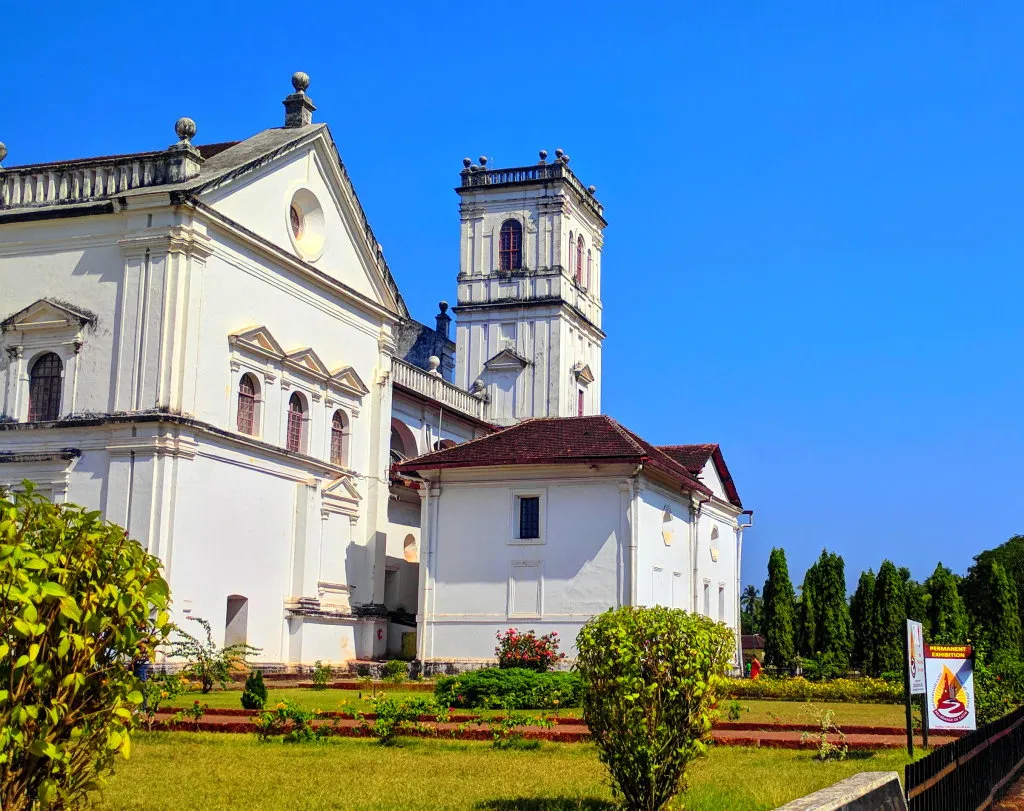
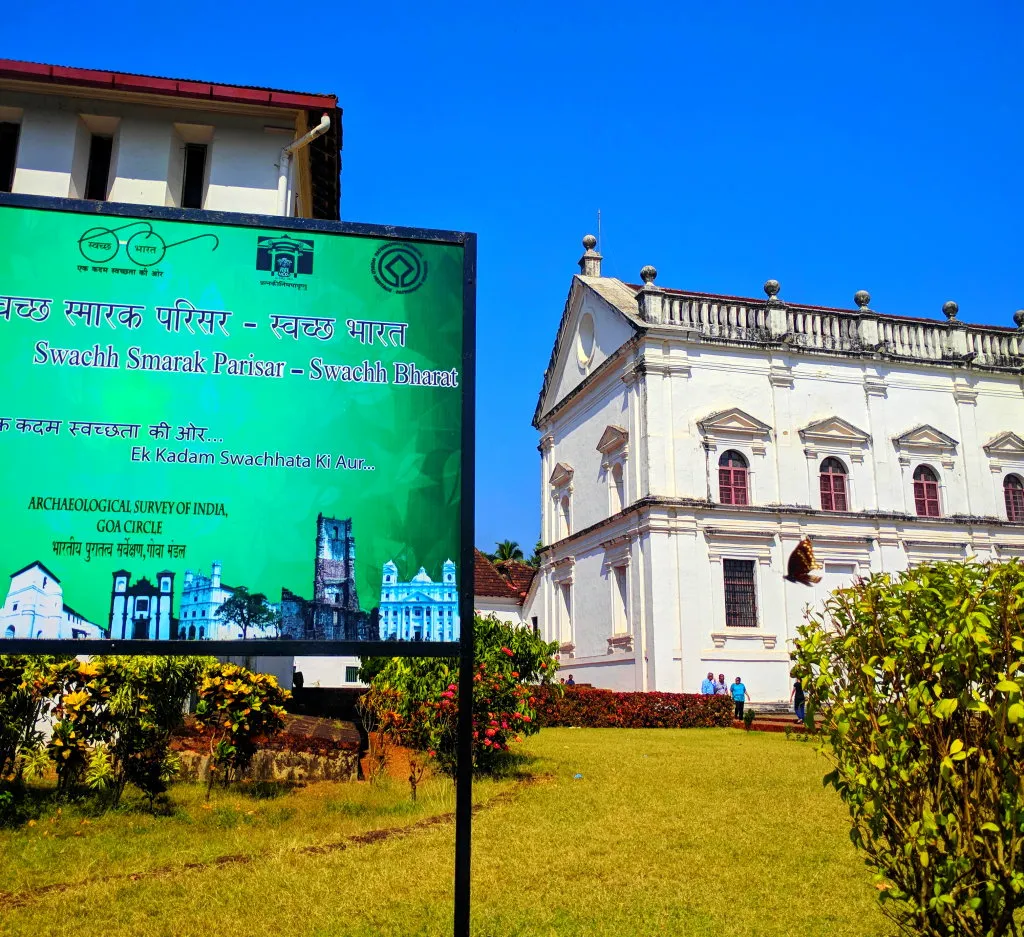
One cannot help be in awe of the designs and motifs used to adorn the cathedral. Here and there, you see the flair of the Indian geometrical and organic patterns, but for most part you're transported to a place that is distinctly European.
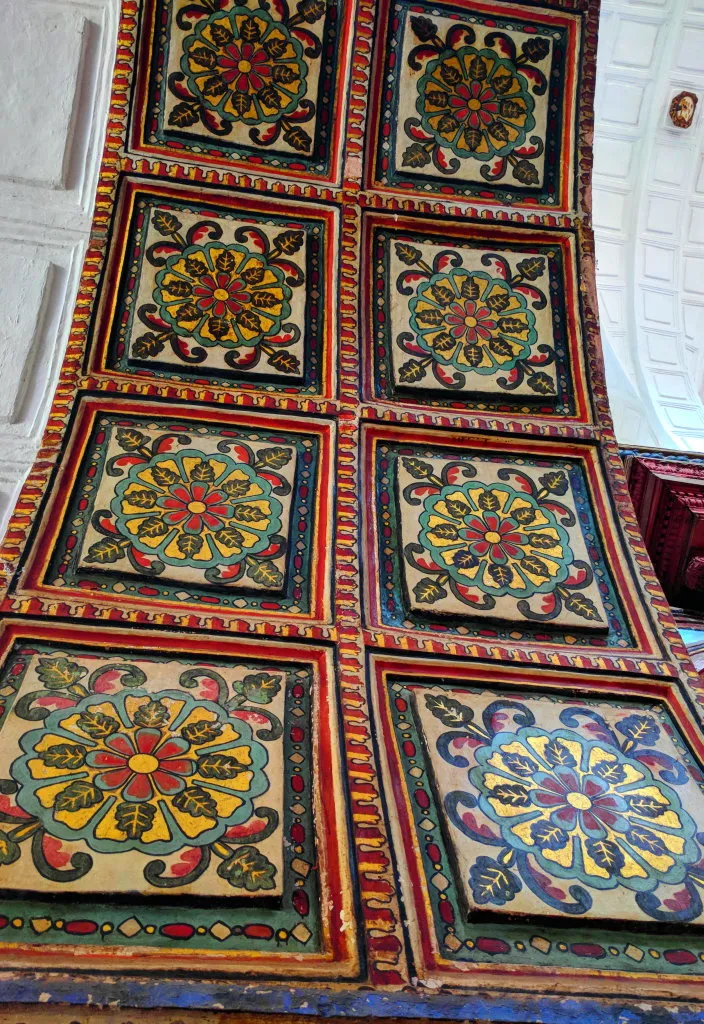

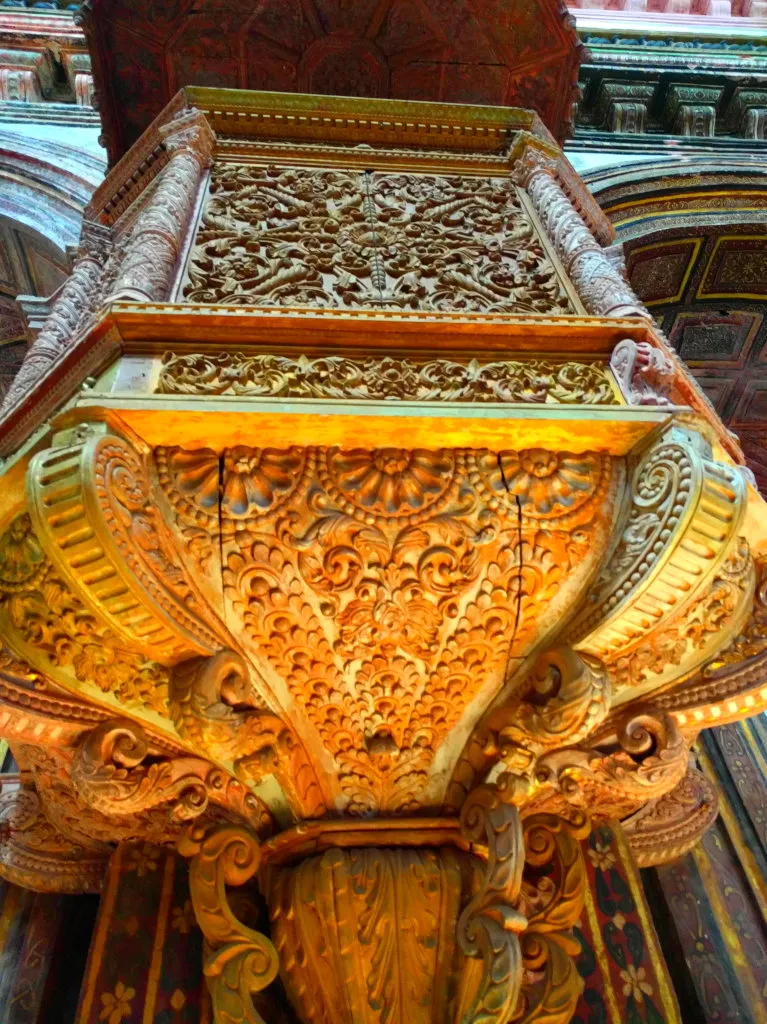
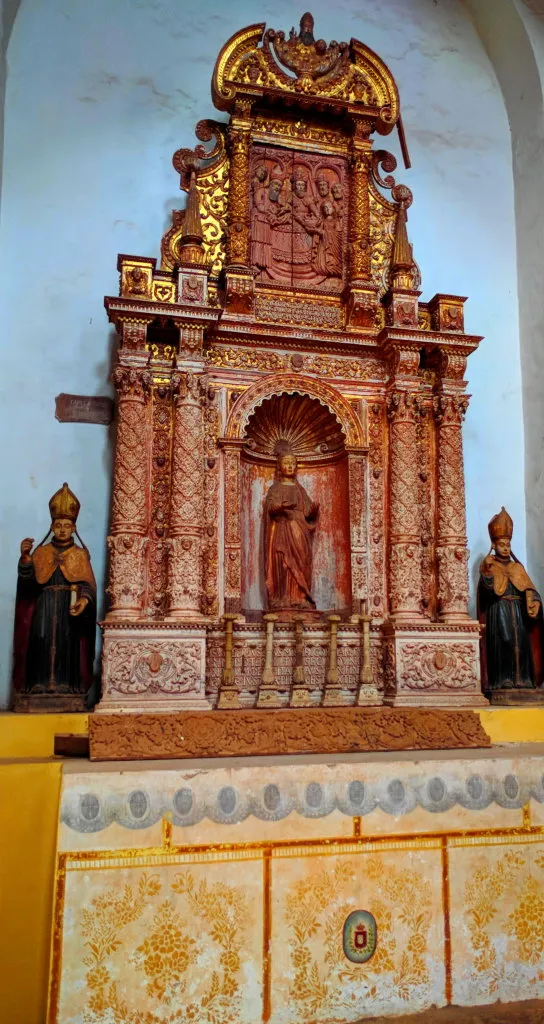
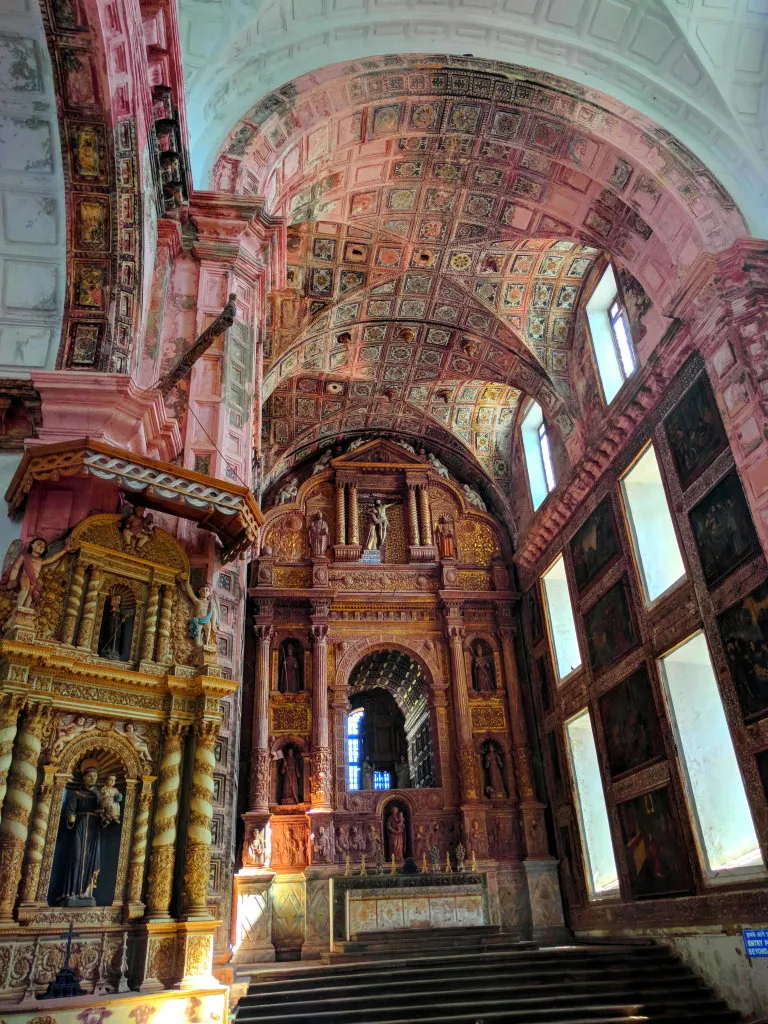
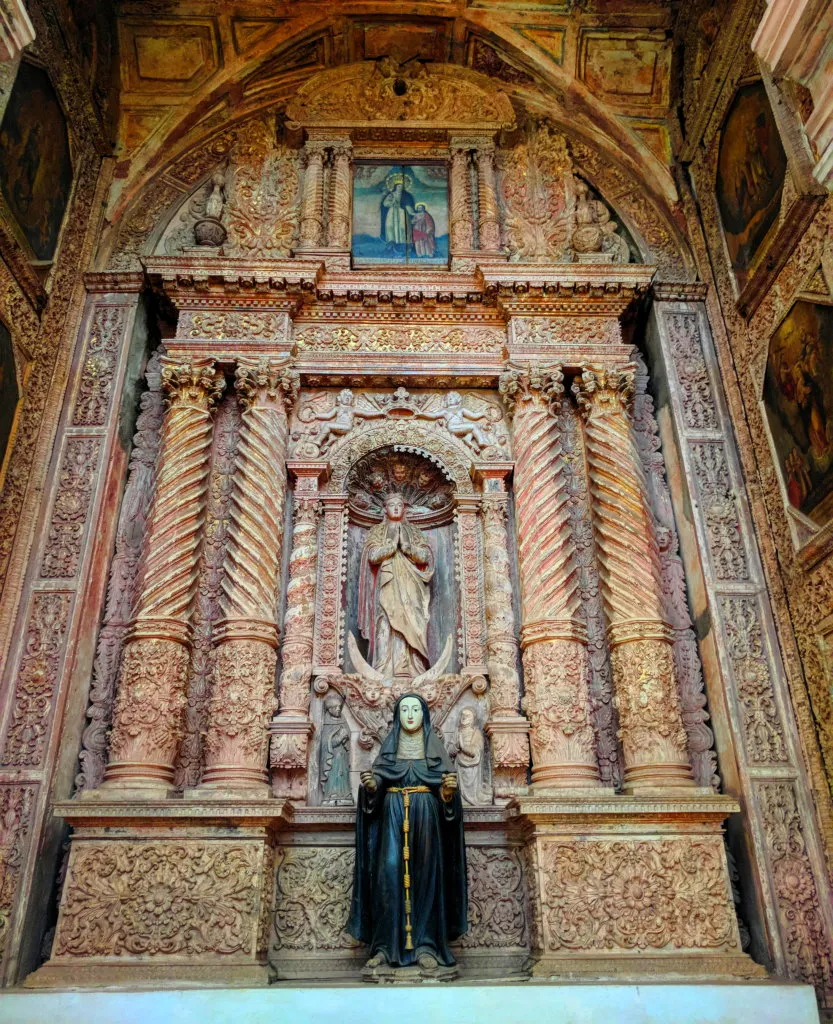
At the archaeological museum, we saw artifacts from Indian and Portuguese cultures. Many of the Indian artifacts in the collection emphasized the body, especially the female form in all her glorious (and voluptuous) beauty. Along one of the exhibition halls, I saw a large statue of a demon, his bulging eyes staring maniacally and his phallus erect. A couple of veiled ladies walked by and broke into peels of laughter upon seeing the aroused demon, who was said to be the spirit of a ghost. Traditionally, people made offerings of sandals and liquor. Across from the aroused demon, the statue of St. Katherine stood pious and proud in the middle of the courtyard. No photography allowed sadly. So afterwards we just walked around the grounds.
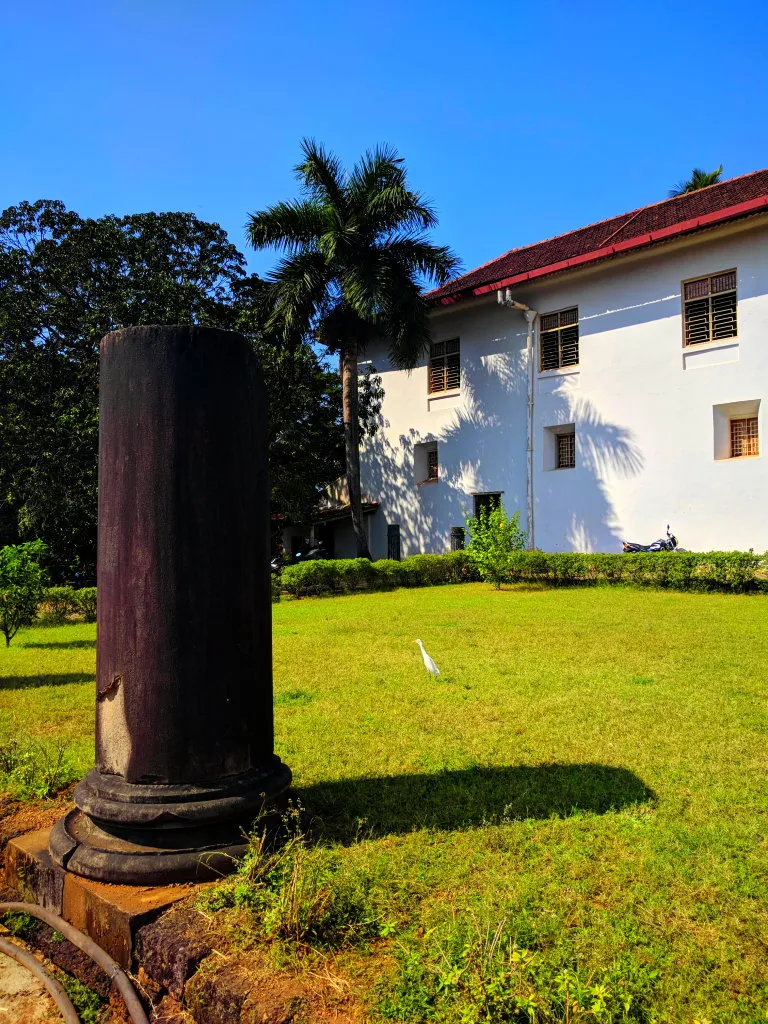

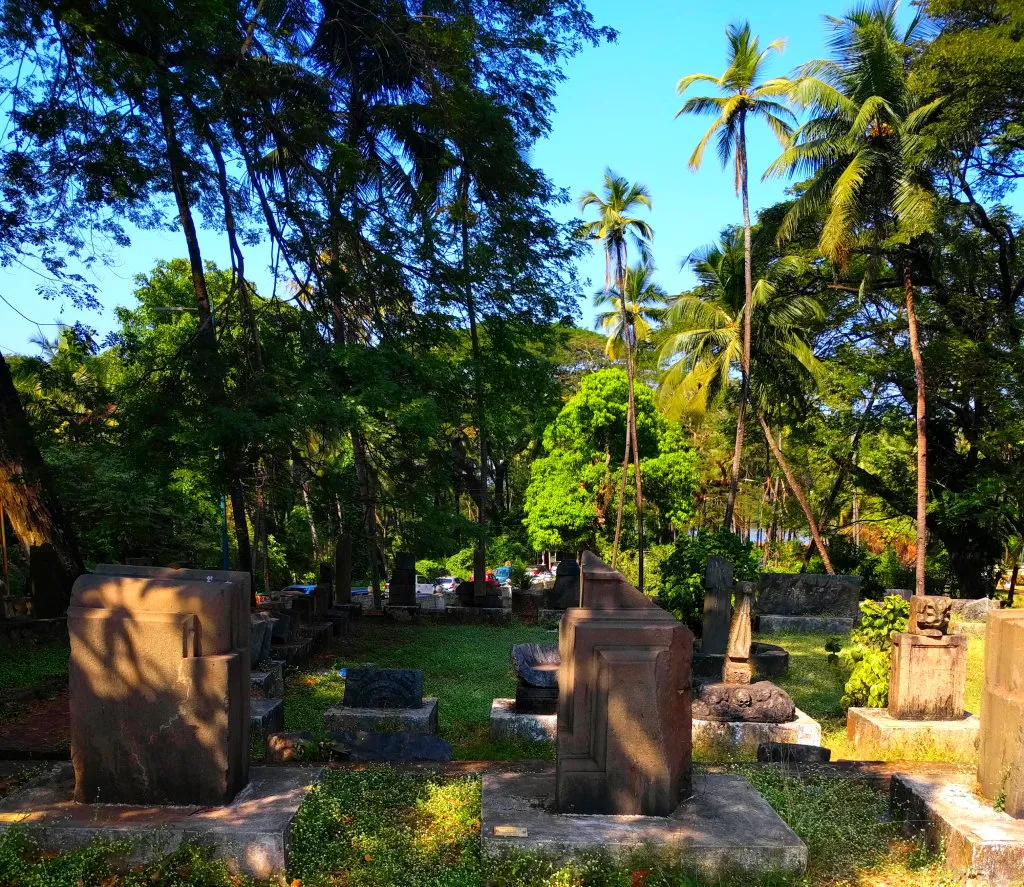
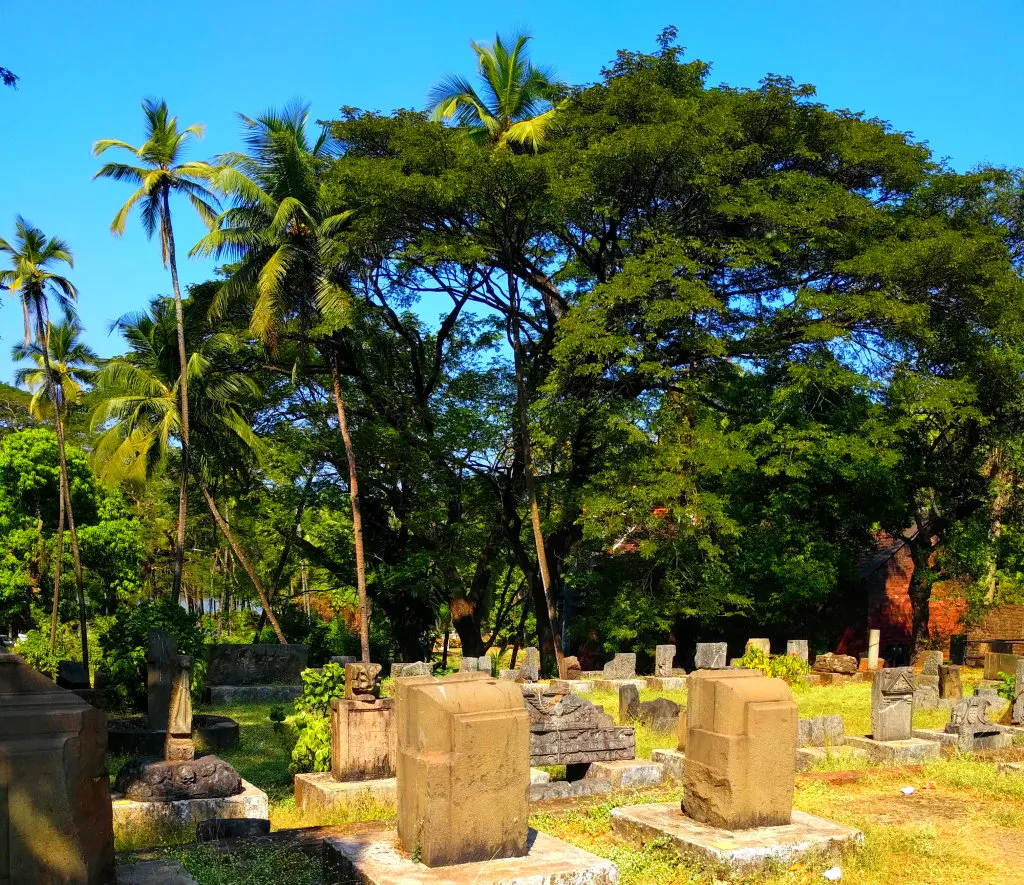
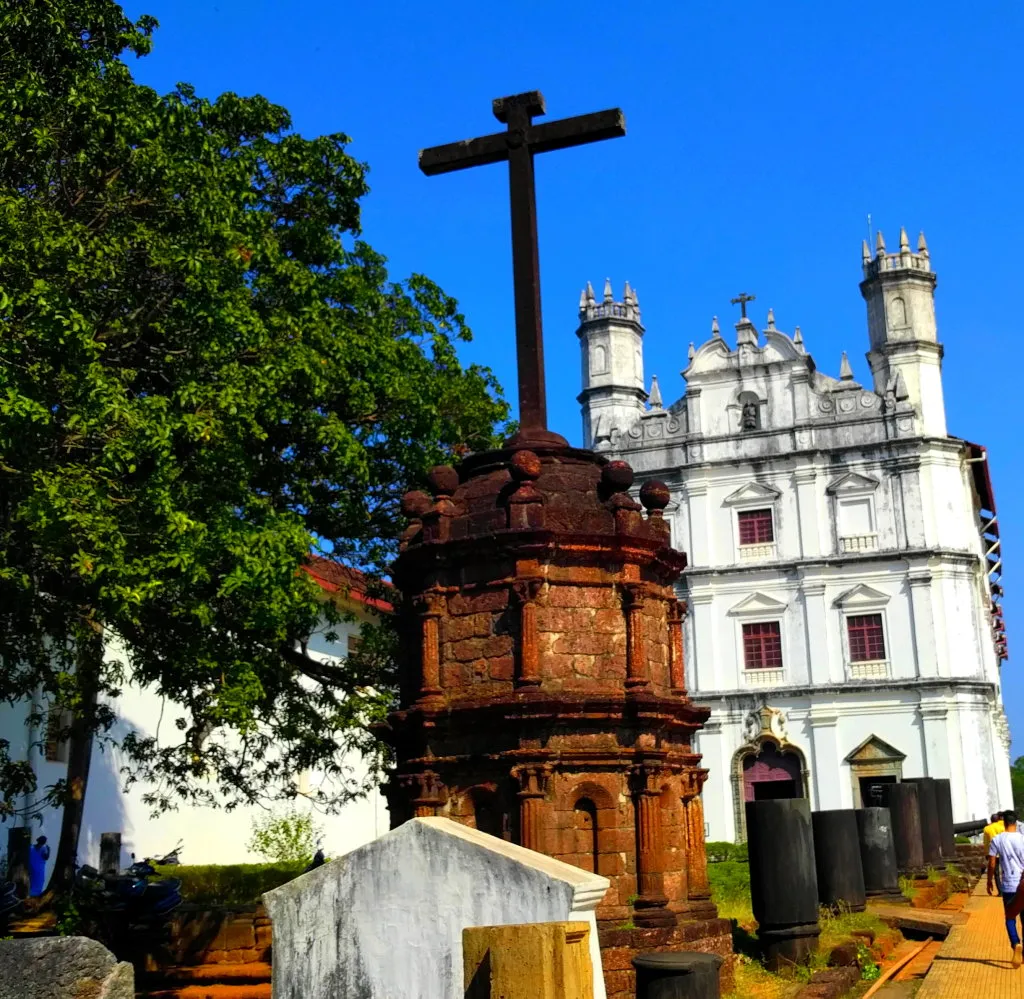
After visiting the key attractions in the area, we found Philip lounging in his taxi waiting for us.
“I take you to another place,” he said.
We hopped in the taxi and made our way to a place with a broken tower jutting out from a hill. A sign near the entrance identified it as “The Tower of the Church of St. Augustine.” It wasn’t much to look at, given that most of it had collapsed, but it was a fascinating archeological site nonetheless. There were several information panels about the church’s history and restoration efforts.
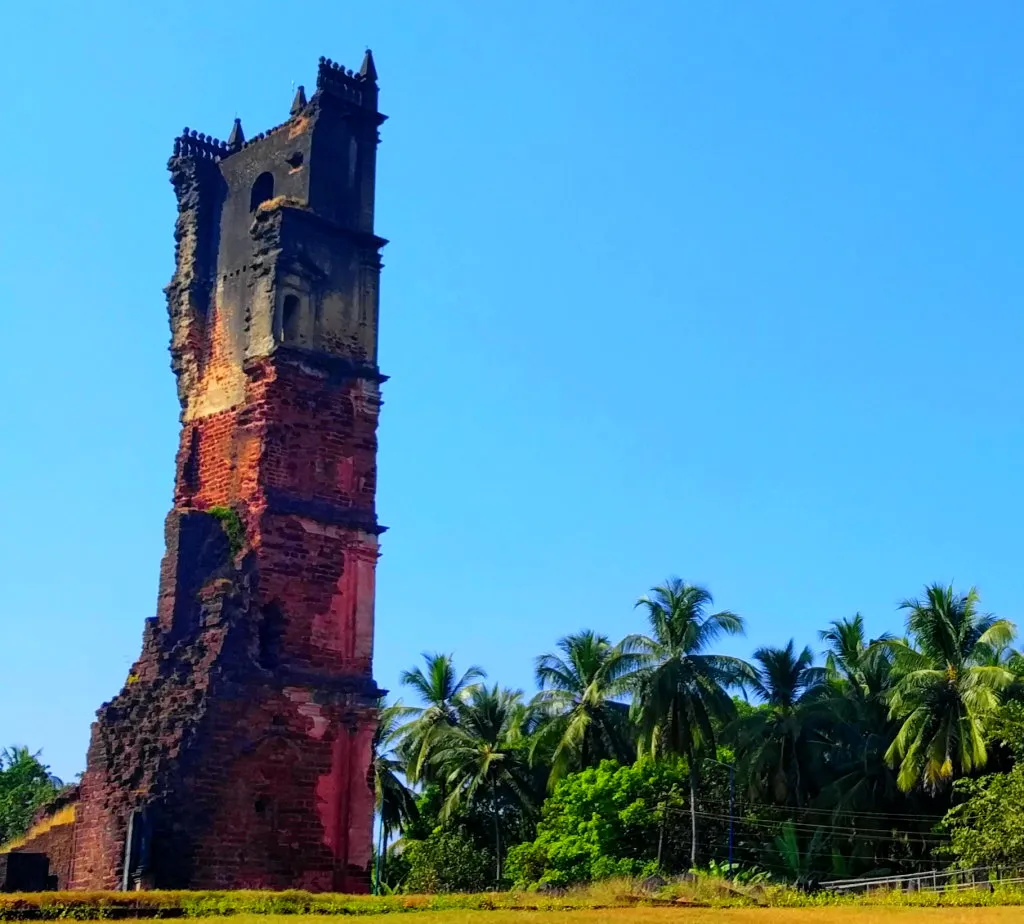
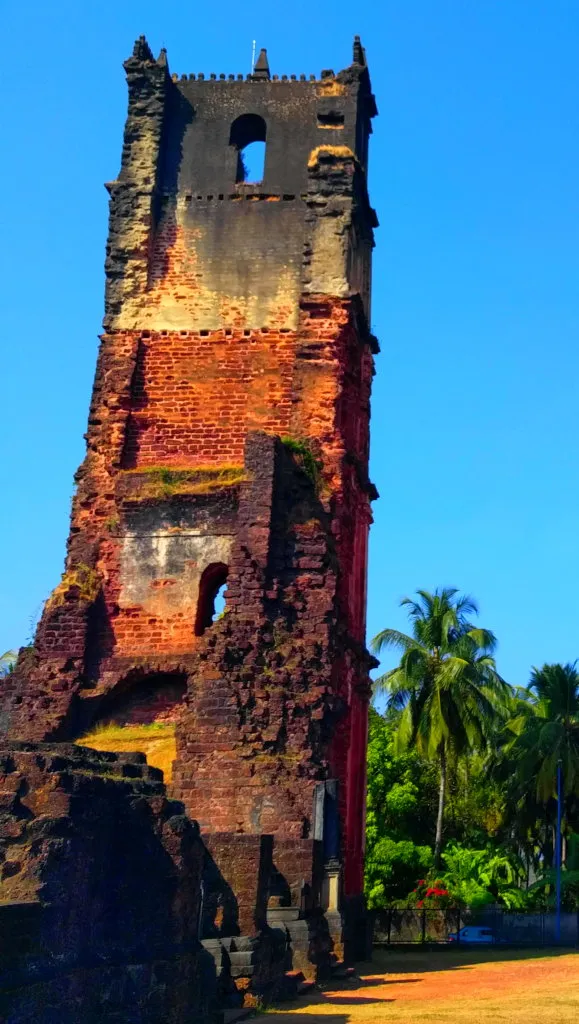
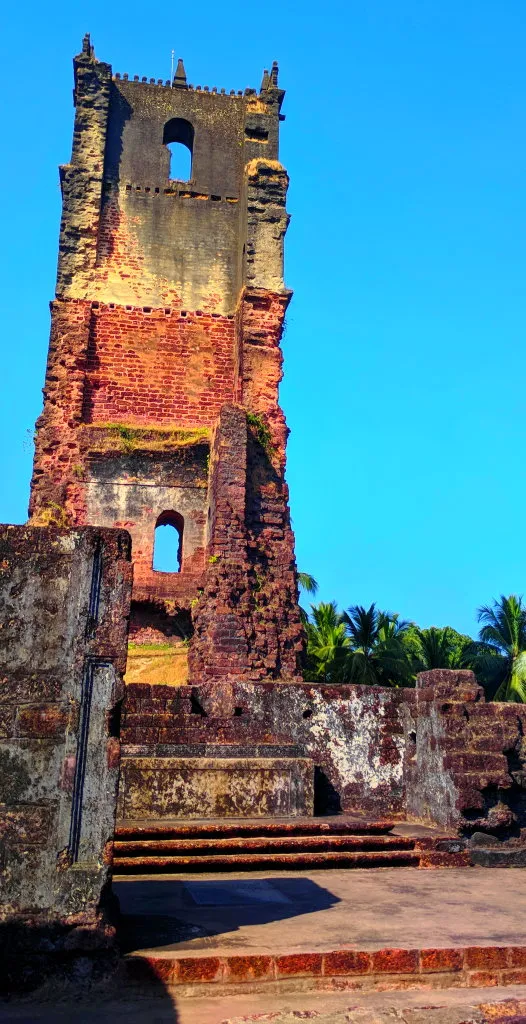
On our way up a hill, a couple of Indian guys approached us.
“Selfie?”
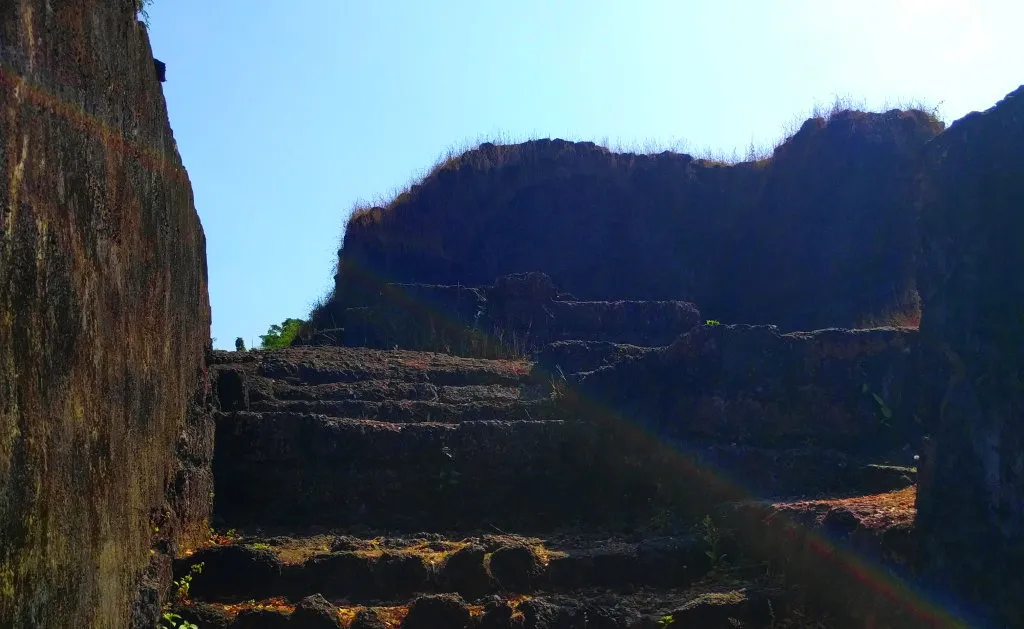
This was a key moment that would color the rest of the trip. We soon learned that many Indian tourists love to take selfies with western tourists. It was a cheerful interaction, but even though it was fun and delightful the first few times, it soon lost its charm. In crowded spaces, you could expect to stop every couple of minutes, grin, and take a selfie. Guys of course were more interested in Bianca, but the Indian ladies usually called me into the picture when they saw me trying to stealthily move away from the selfie mayhem. Ah the memories!
I stood in the middle of the courtyard looking around me. The collapsed tower stuck out like an old jagged finger. Standing in the ruins of what would’ve been the living quarters of those ancient Portuguese men AND women. Apparently, there was also a convent here. So, while standing there, I imagined the men and women cohabiting in this place on steamy Goan nights, candles flickering in the ghostly halls; I imagined them praying, reading, or performing some archaic Christian ritual in the sweaty night. What did they see when they looked homesick across the city? Alone and yearning. There was a clear view of the other churches in the area, so perhaps that was a bit of comfort to see other members of the Christian community at large.
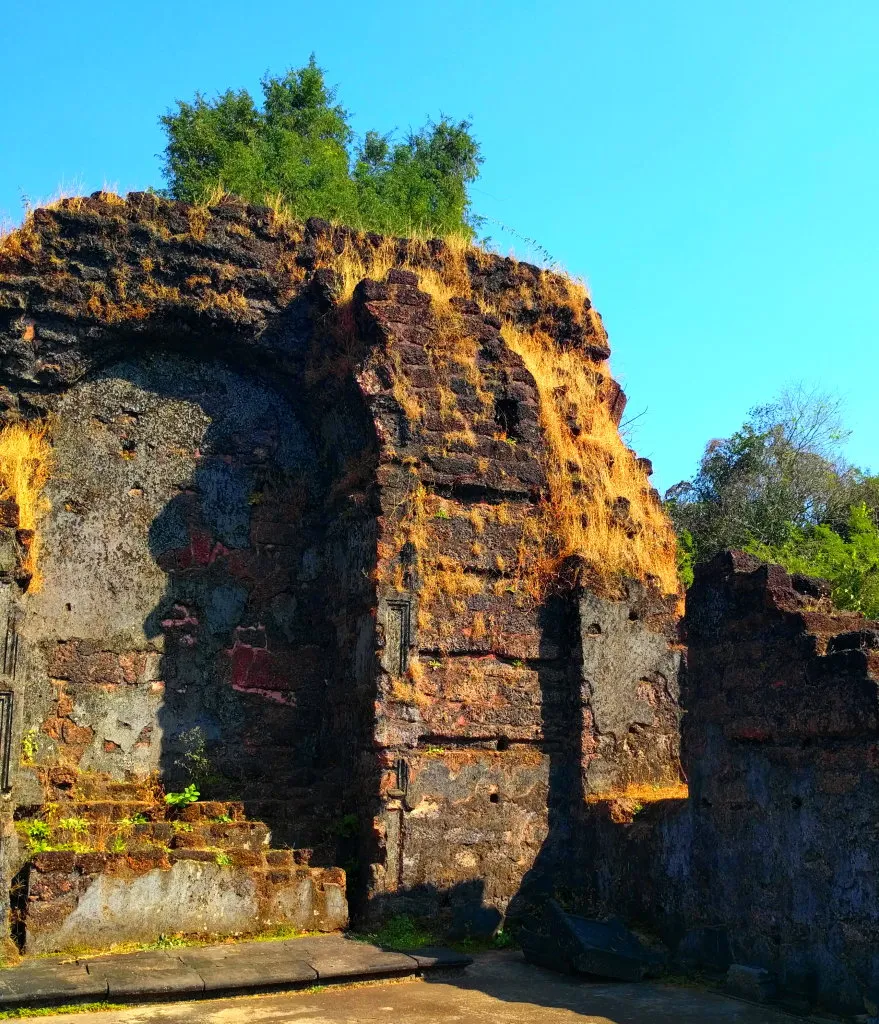
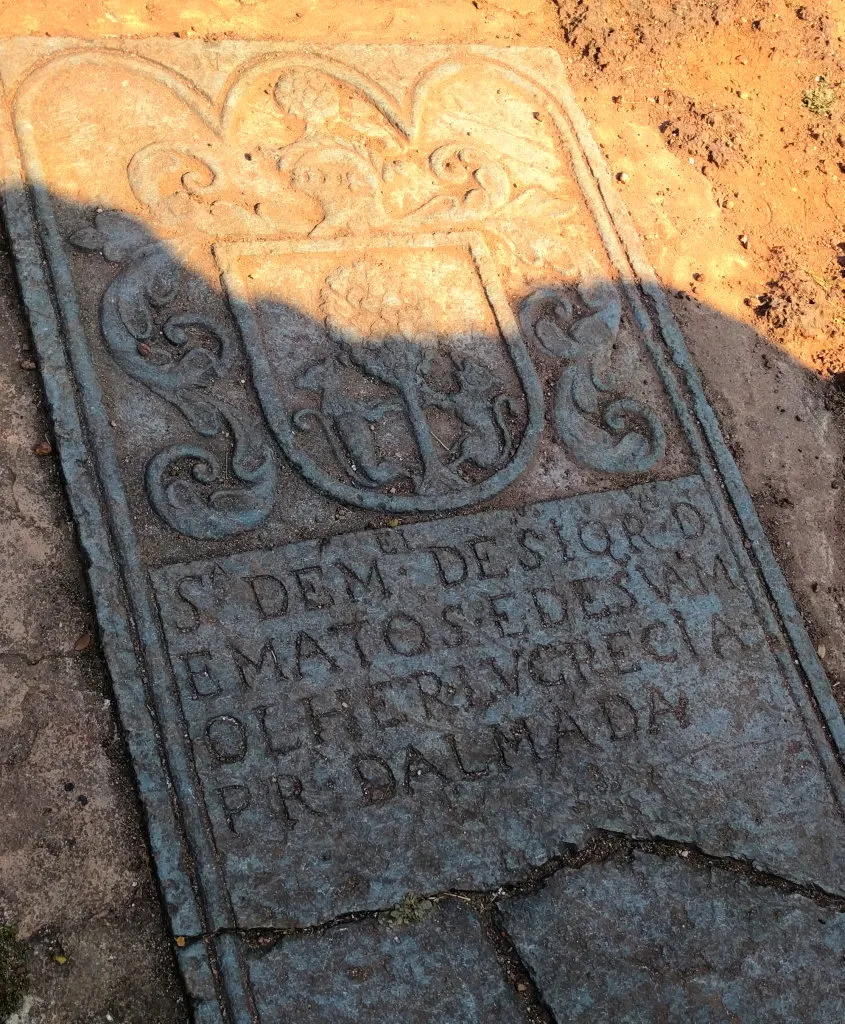
I particularly enjoyed seeing the “azulejos” tile-work on the floors and walls of the church. If you’ve been to Portugal, or neighboring Spain, you’d probably seen the use of colourful blue tiles adorning walls and streets. One can only imagine what they must’ve looked like in its heyday, when the tiles had been freshly lain so long ago.
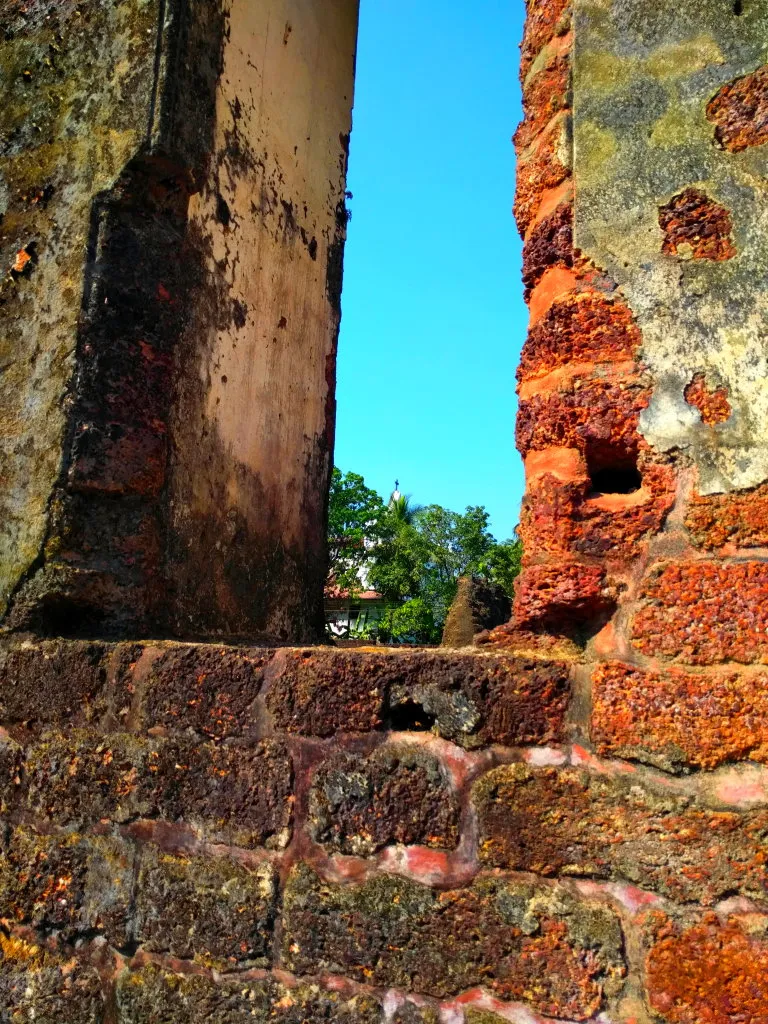
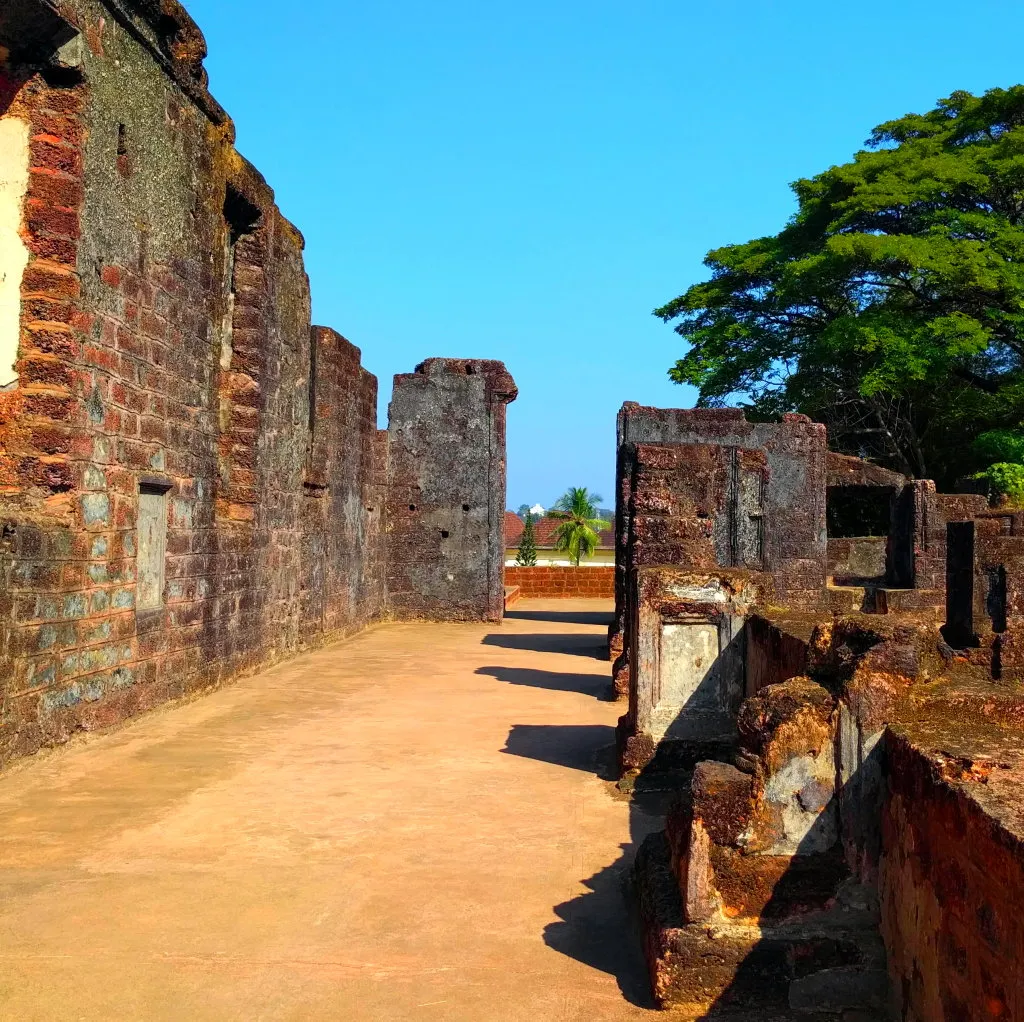

Philip drove us back to the hotel. We gave him a good tip for going above and beyond what we expected. That’s the thing about many taxi and tuk-tuk drivers that we encountered. They all seemed to have some complicated scheme to make us part with our money, but once we entered the commercial relationship, they treated us like royalty.
“Do you want to go see the fireworks tonight?” Bianca said when we were back at the hotel.
“Wouldn’t miss it for anything,” I replied. “But first I need a beauty sleep.”
At the urging of St. Francis Xavier, the Inquisition did show up in Goa with dire consequences for those who did not toe the line. The struggles did not stop there but continued throughout Goa’s tumultuous history. It is a wonder now, centuries later, that we can shake hands, enjoy each other’s company, and take a selfie or two.
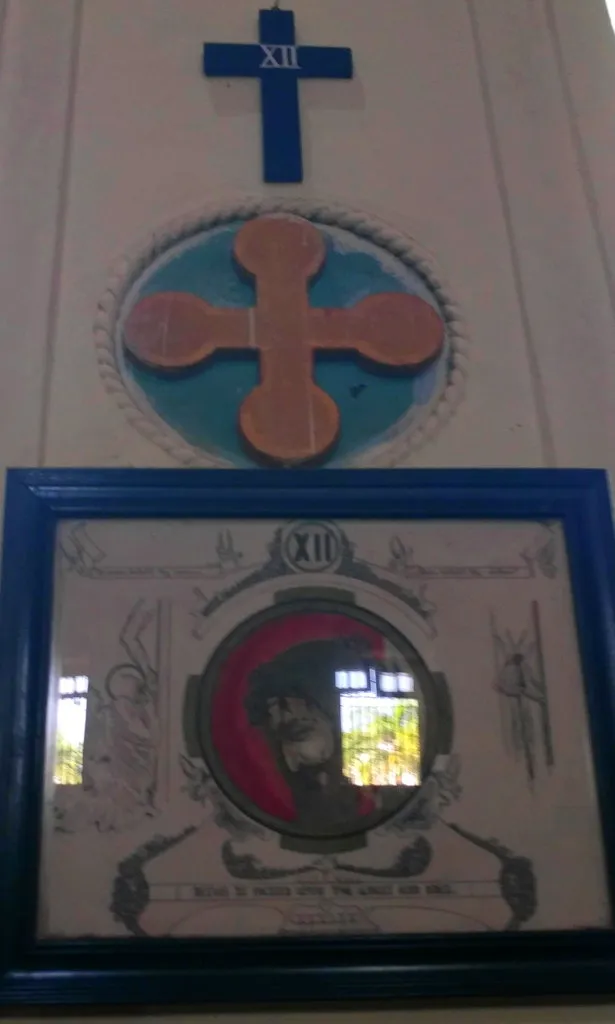
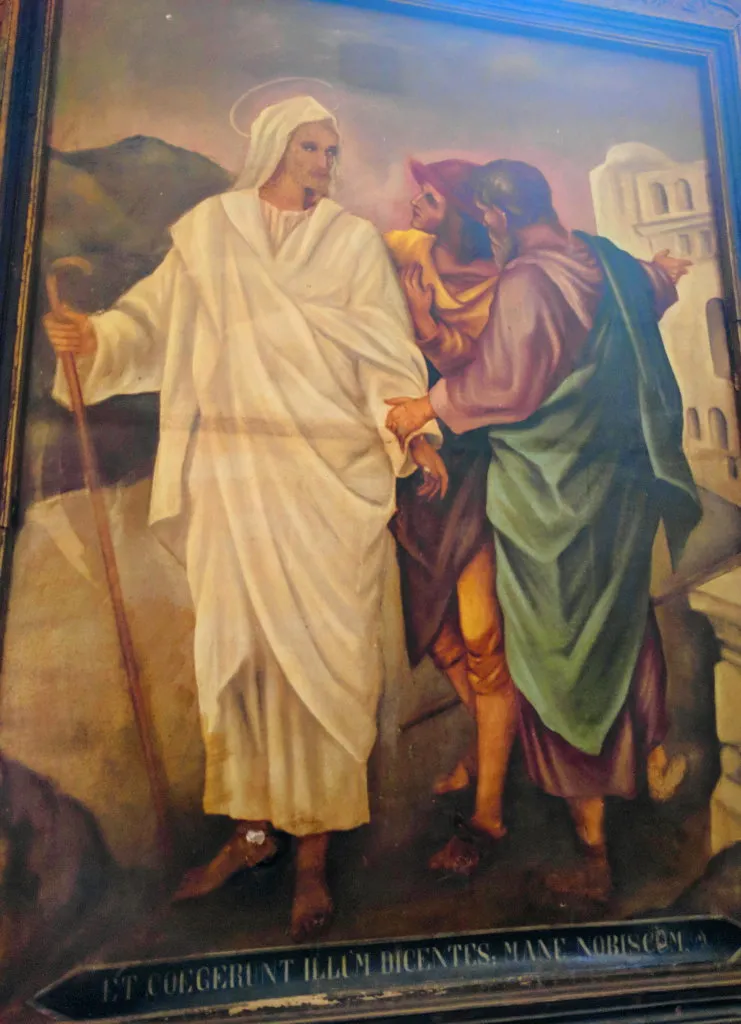
Resources on the history of Goa and St. Francis Xavier
Body of St. Francis Xavier
Atlas Obscura. http://www.atlasobscura.com/places/body-st-francis-xavier, accessed August 1, 2022.
Churches and Convents of Goa
2021 Wikipedia. https://en.wikipedia.org/w/index.php?title=Churches_and_convents_of_Goa&oldid=1047353673, accessed August 1, 2022.
Editors, Biography com
Saint Francis Xavier. Biography. https://www.biography.com/religious-figure/saint-francis-xavier, accessed August 1, 2022.
Francis Xavier - Wikiquote
https://en.wikiquote.org/wiki/Francis_Xavier, accessed August 1, 2022.
Life of St. Francis Xavier
https://stfrancisxavierofficial.com/bom-jesus-goa/St-Francis-Xavier-life.html, accessed August 26, 2022.
Portuguese Goa
World History Encyclopedia. https://www.worldhistory.org/Portuguese_Goa/, accessed August 1, 2022.
Shetty, Sneha
Feast of St Francis Xavier, Goa: 6 Facts You Must Know about the Saint | India.Com. https://www.india.com/travel/articles/feast-of-st-francis-xavier-goa-6-facts-you-must-know-about-the-saint-3237251/, accessed August 1, 2022.
The Life of Saint Francis Xavier
https://www.olrl.org/lives/xavier.shtml, accessed August 1, 2022.
Who Was Francis Xavier?
Xavier University. https://www.xavier.edu/mission-identity/xaviers-mission/who-is-francis-xavier, accessed August 1, 2022.
Dive into another section:
1.1, 1.2, 1.3, 1.4, 2.1, 2.2, 2.3, 2.4, 3, 4.1, 4.2, 4.3, 5.1, 5.2, 6.1
Images by @litguru